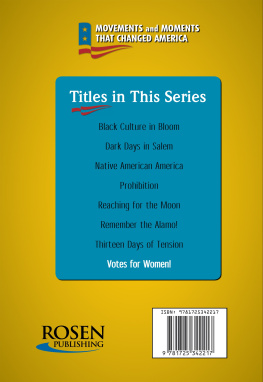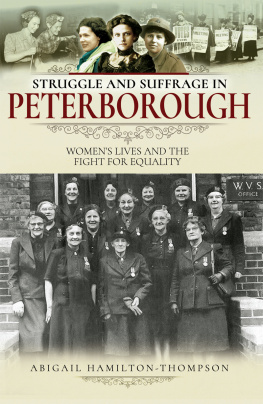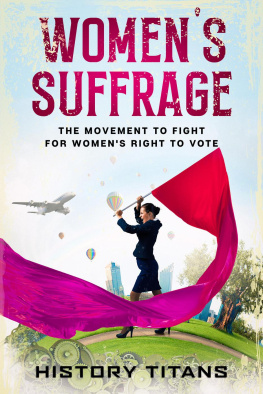Struggle and Suffrage in Swindon
Struggle and Suffrage in Swindon
WomenS Lives And The Fight For Equality
By Frances Bevan
First published in Great Britain in 2019 by
Pen & Sword History
An imprint of
Pen & Sword Books Ltd
Yorkshire Philadelphia
Copyright Frances Bevan, 2019
ISBN 978 1 52671 821 1
eISBN 978 1 52671 823 5
Mobi ISBN 978 1 52671 822 8
The right of Frances Bevan to be identified as Author of this work
has been asserted by her in accordance with the Copyright,
Designs and Patents Act 1988.
A CIP catalogue record for this book is available from the British Library.
All rights reserved. No part of this book may be reproduced or transmitted
in any form or by any means, electronic or mechanical including
photocopying, recording or by any information storage and retrieval system,
without permission from the Publisher in writing.
Pen & Sword Books Limited incorporates the imprints of Atlas,
Archaeology, Aviation, Discovery, Family History, Fiction, History,
Maritime, Military, Military Classics, Politics, Select, Transport, True
Crime, Air World, Frontline Publishing, Leo Cooper, Remember When,
Seaforth Publishing, The Praetorian Press, Wharncliffe Local History,
Wharncliffe Transport, Wharncliffe True Crime and White Owl.
For a complete list of Pen & Sword titles please contact
PEN & SWORD BOOKS LIMITED
47 Church Street, Barnsley, South Yorkshire, S70 2AS, England
E-mail:
Website: www.pen-and-sword.co.uk
Or
PEN AND SWORD BOOKS
1950 Lawrence Rd, Havertown, PA 19083, USA
E-mail:
Website: www.penandswordbooks.com
Acknowledgments
This is the book I have always wanted to write. My thanks go to the many people who have shared their family history with me and allowed me access to private photographs, letters and memorabilia, particularly Tamara Dugdale, the great niece of Swindon Suffragette Edith New. My thanks go to Wendy Burrows, Christine Price, Kay Prosser and Di Edelman for sharing their research on the fascinating Alley sisters and to Steve Arman, Peter Guggenheim, Mimi Martin, Shelley Hughes and Mike Attwell for photographs and memories of Celia Pitt, Jane Helena Tuckey, Fanny Catherine Hall, Maria Matthews and the Dixon family. Thank you to my colleagues at Swindon Heritage, Graham Carter and Mark Sutton and contributing writers Noel Beauchamp, Noel Ponting, Paul Wilkins, Janet Flanagan and Karen King for their support and for sharing their research.
Thank you to the team at Local Studies, Central Library, Darryl Moody and Katherine Cole (who brought to my attention the story of Eileen Babington Kostitch), for their encouragement, help and advice and for providing some fantastic photographs.
And on the subject of photographs, many thanks to Paul Williams, custodian of the William Hooper archive and Andy Binks, Chair of the Swindon Society for allowing me access to their collections. Thank you also to Swindon Borough Council and Lydiard House for the images of May George and Mary, Viscountess Bolingbroke.
Thank you to the inspirational Rosa Matheson and last but not least thank you to my family for putting up with my obsession over many more years than it has taken me to write this book, Leah, Adam, Nina and my husband Steve.
Introduction
The story of Swindon in 1850 was a tale of two towns. The settlement on the hill had a road-plan dating back to the fourteenth century and archaeological finds from the Neolithic period. In the seventeenth century it was a small market town considered to be of little importance, with a population of just 791 in 1697. Among those considered worthy of recording were fourteen yeomen, a lay rector, male members of the Vilett family and several clergymen, but no women.
In 1841 Isambard Kingdom Brunel, the inspirational chief engineer at the Great Western Railway Company was looking for somewhere on the London to Bristol line to situate a repair and maintenance depot. His second in command, Daniel Gooch, suggested Swindon. The Wilts & Berks canal had been completed in 1810 and would prove useful in the construction of the railway factory. By 1848 the railway factory employed 1,800 men but no women.
The rows of redbrick terrace houses that crept up the hill from the new industrial town at the bottom were named in honour of the great and the good of Swindon; the men who had sold their land to make the expansion possible and those who held positions of authority within the railway works, but where were the women?
This was the question historian Dr Rosa Matheson asked when she began a research project to study the role of women in the railway industry: I wanted to write women into history because basically they have been written out. Dr Mathesons research led to the publication of her book The Fair Sex Women and the Great Western Railway , published in 2007.
So where did the women work before the railway works opened their doors to them?
One of the recurring themes of this history of women in Swindon was the lack of employment, especially for married women.
As early as 1870, Joseph Armstrong, Locomotive, Carriage and Wagon Superintendent, at the GWR Works acknowledged the dearth of employment opportunities for the daughters of the skilled railway men he was trying to attract to New Swindon.
The notion of the angel in the house, the woman who devoted all her time and energies to her husband, children and home, was largely a middle-class construct; for the working-class woman it was a quite a different reality. Yet throughout the 18501950 period womens work continued to be structured around domestic responsibilities, was gender specific, generally low status and low paid, and was frequently omitted from census returns.
The reason for this is attributable to the inconsistent datagathering instructions issued for each census. In 1851, for example, only those women who were regularly employed had their occupation recorded. The occupation of homeworkers and those women employed in a family business was often not recorded on the census returns; neither were those whose work was part-time, seasonal or casual. Census data relating to womens work is therefore largely unreliable.
The Victorian period is often referred to as the Age of Reform and change was on its way. The Married Womens Property Act 1870 gave married women control over the money they earned and any inherited property they had brought to the marriage. The 1882 Act went further and allowed married women to own and control property in their own right. These Acts benefited women who enjoyed a private income and wealth and who were brave and bold enough to take their husband to court if the occasion demanded. For poor and working-class married women, it had scant relevance and did little to bridge the inequality divide.
After the Representation of the People Act 1918, which extended the franchise to some women over the age of 30 with property qualifications, came the Sex Disqualification Removal Act 1919.








